If you want to effectively communicate with customers in your market, you have to know who they are. Think about it in terms of public speaking. If the speaker doesn’t know their audience, they risk choosing a topic the audience doesn’t care about, using language they won’t understand, and struggling to motivate them to take desired follow-up actions.
On the other hand, a speaker with a clear understanding of their audience can speak directly, clearly, and persuasively. So, here’s the question: how do you get to know your audience?
In a marketing context, analyzing website demographics is one way to develop a clearer view of who you’re talking to. Unpacking the data allows you to communicate more effectively with potential customers, increase audience reach, and inspire the action you desire.
What Are Website Demographics?
Broadly speaking, demographics are the characteristics of people within a group. The group of people could be as large as an entire nation or city, or as small as a school, company, or even a marketing team.
By analyzing a group’s characteristics, you can generate demographic data that allows you to better understand the group’s makeup. In other words, you’ll discover who the people in the group actually are.
In the case of your website, visitor demographics are the characteristics of the people who come to your site. Some common website audience demographics include:
- Age
- Gender
- Geographic location
- Employment status
- Education level
- Income bracket
- Mode of access (mobile vs. desktop)
- Channels of access (social media vs. search engine vs. direct)
Once you have insights into your audience’s demographic makeup, it’s much easier to imagine your customers. And once you know who your customers are, you can reach them with your marketing efforts more effectively.
Why Compare Demographic Data with Your Competitors?
While understanding your own website demographics is important, comparing your data with your competitors can provide key insights that can make you more competitive in the larger market.
Comparing your demographics with those of your competitors allows you to study:
- Where your audience overlaps with your competitors
- Where your audience and your competitors’ audience are different
- Where your efforts are succeeding or failing
- What portion of the relevant audience you haven’t yet engaged
When it comes to expanding your audience, knowing where your target audience spends their time online can help you make important decisions about where to direct your marketing efforts.
First, let’s look at an Audience Overlap graph from the Semrush One2Target tool’s Audience Overlap Report to see what insights might be gained.
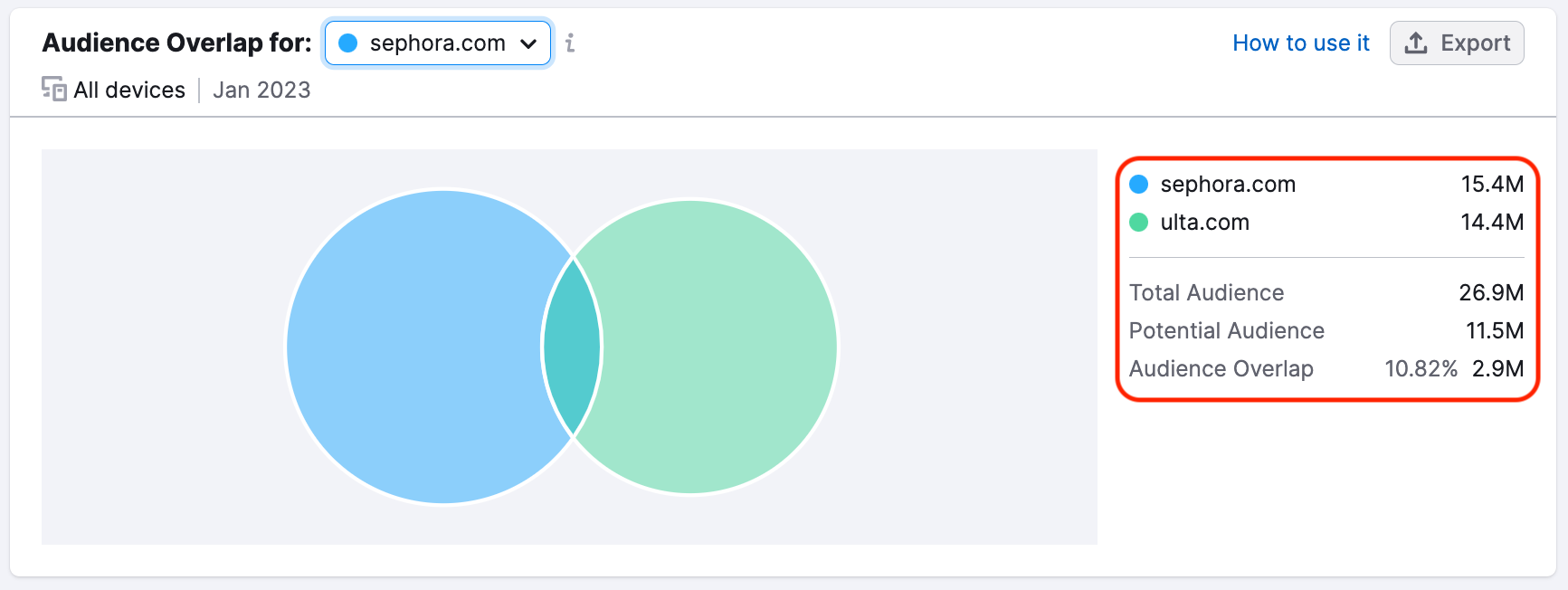
Here, we’ve compared sephora.com and ulta.com. Both are major makeup retailers, though their overlap is relatively small. This suggests strong brand loyalty from customers, but also presents a large opportunity. For example, Sephora might want to try to capture some of Ulta’s audience. As shown in the highlighted portion of the image above, the Potential Audience to be gained sits at 11.5M.
So, who are these audience members that sephora might look to capture? And why does understanding their demographics matter? First, let’s jump over to One2Target’s Demographics Report to see if we can distinguish any differences between these two brand’s audiences.
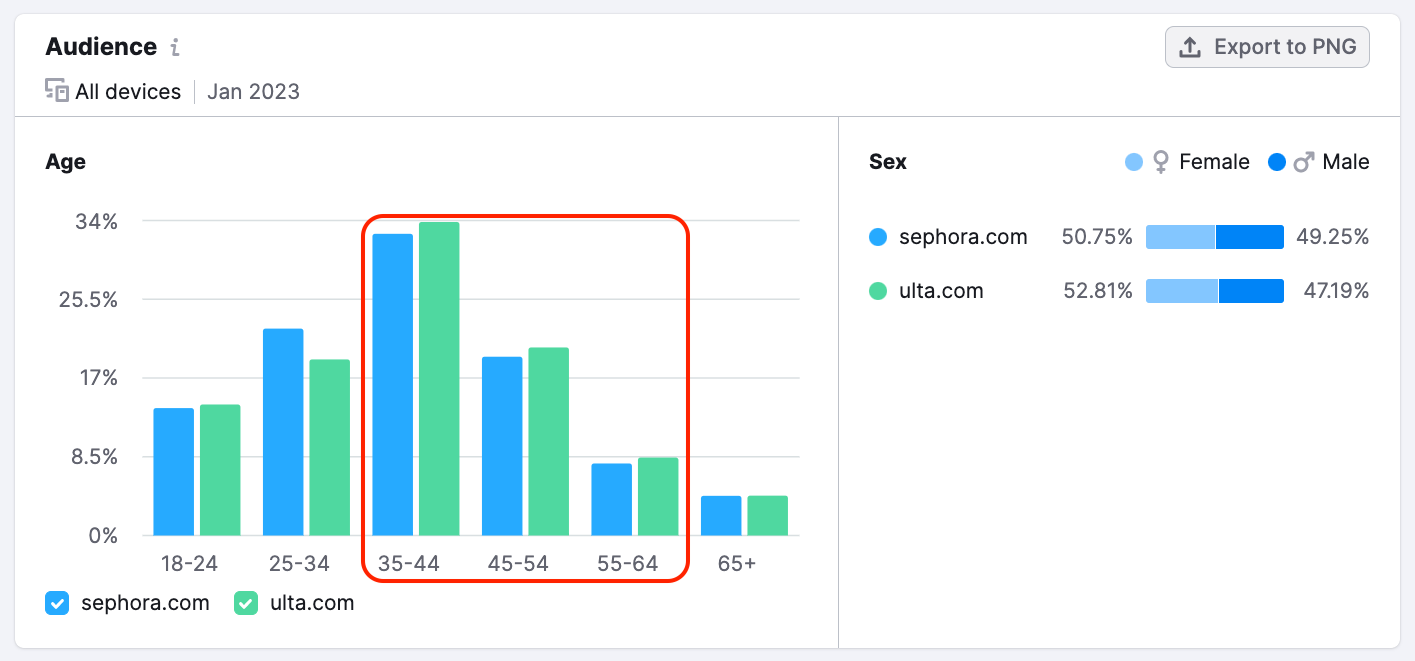
Notice the green bars representing Ulta in the highlighted age brackets. It appears Ulta is reaching a larger audience in higher age ranges than Sephora.
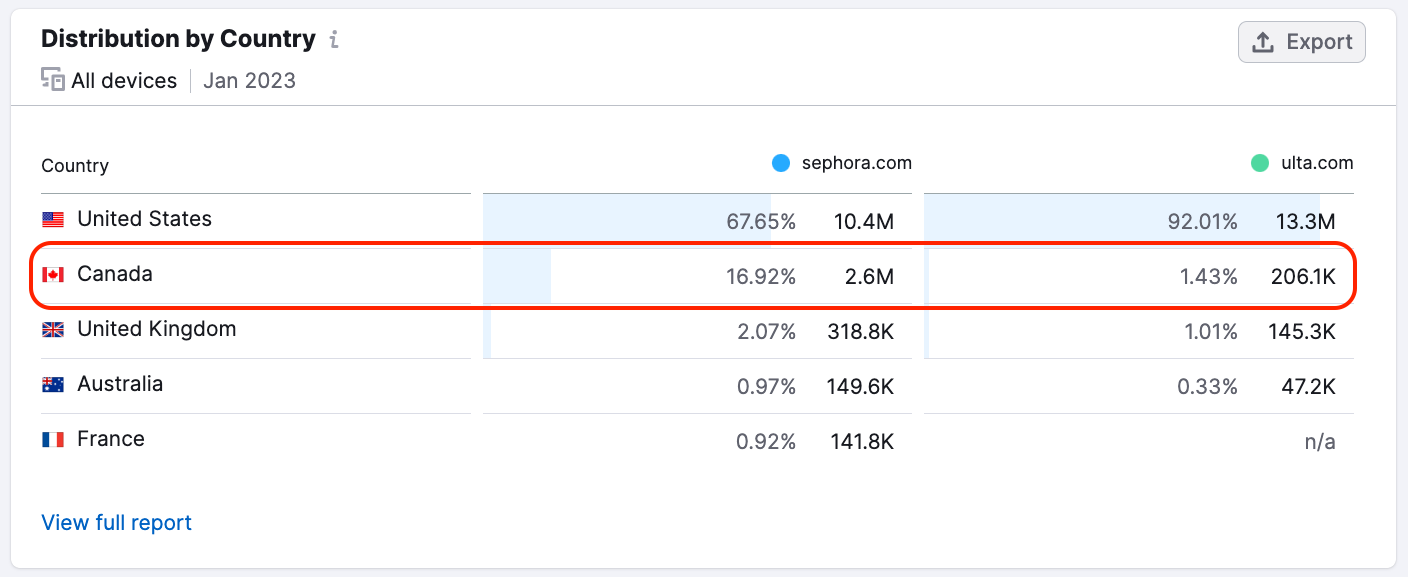
Taking Ulta’s perspective, we looked at the geographic breakdown of both sephora.com and ulta.com’s audiences, and we discovered some variations.
While almost 17% of sephora.com’s visitors come from Canada, ulta.com receives less than 2% from the Canadian visitors. By jumping over to the Market Explorer Tool and reviewing the Geo Distribution Report, we can check out the trend.
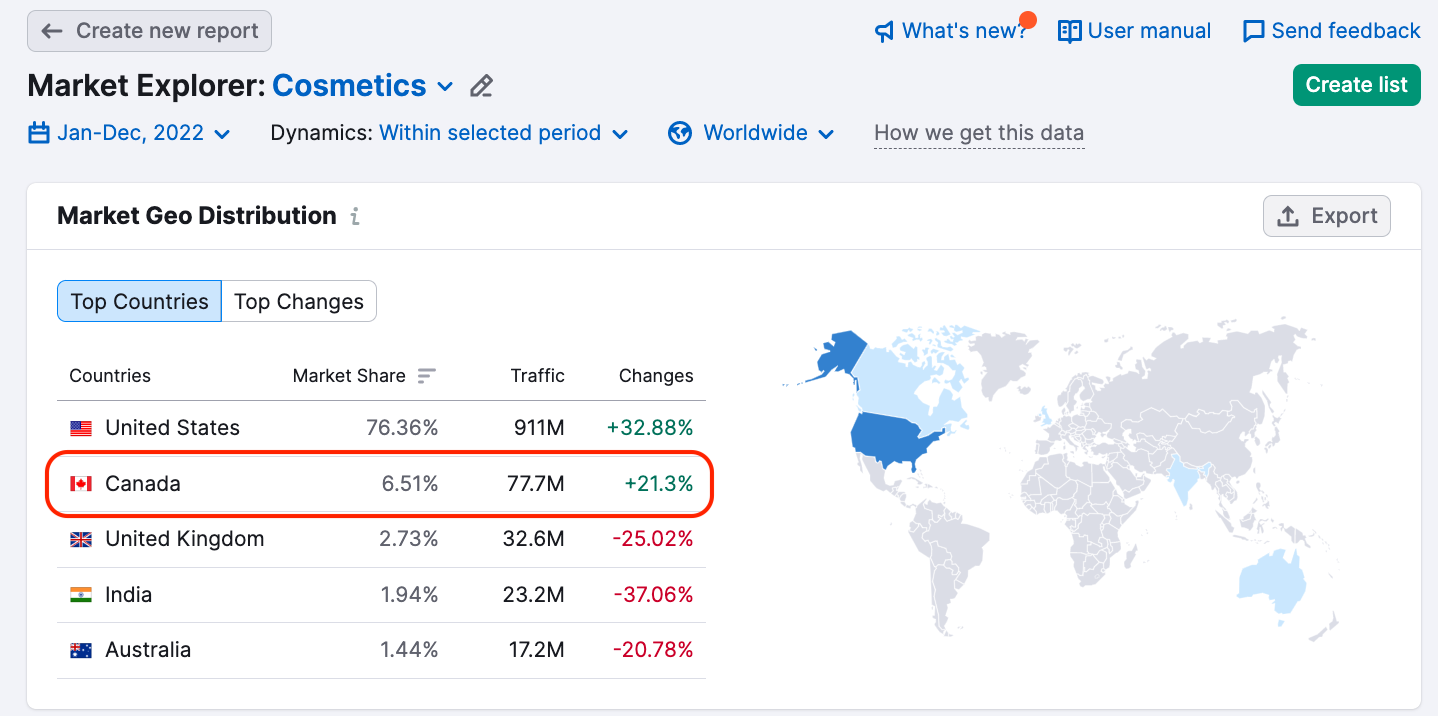
Seeing as the Canadian market for Cosmetics grew 21% in 2022, it seems like a demographic segment Ulta may not want to ignore.
How Do You Gather Demographic Data for Your Market and Competitors?
Now that we’ve defined the importance of comparing demographic data with competitors, let’s consider some ways to get your hands on competitor’s audience demographic data.
Gathering audience data for market competitors is more challenging than analyzing your own audience. There are many ways of getting demographic data for your own website. The most common software for collecting demographics data is Google Analytics. Likewise, some website building and hosting services like Squarespace offer built-in analytics software that provide insights about your website demographics.
The limitation of Google Analytics and other analytics software is that these tools don’t allow you to view data related to your competitors. For competitive audience data, you’ll need to use another method.
Here are a few options:
- Social media platforms—You can learn a lot about competitor audiences by analyzing their social media accounts to learn about their followers’ demographics, interest categories, and behaviors. Likewise, you can gather social media based data from tools like Hootsuite or Sprout Social.
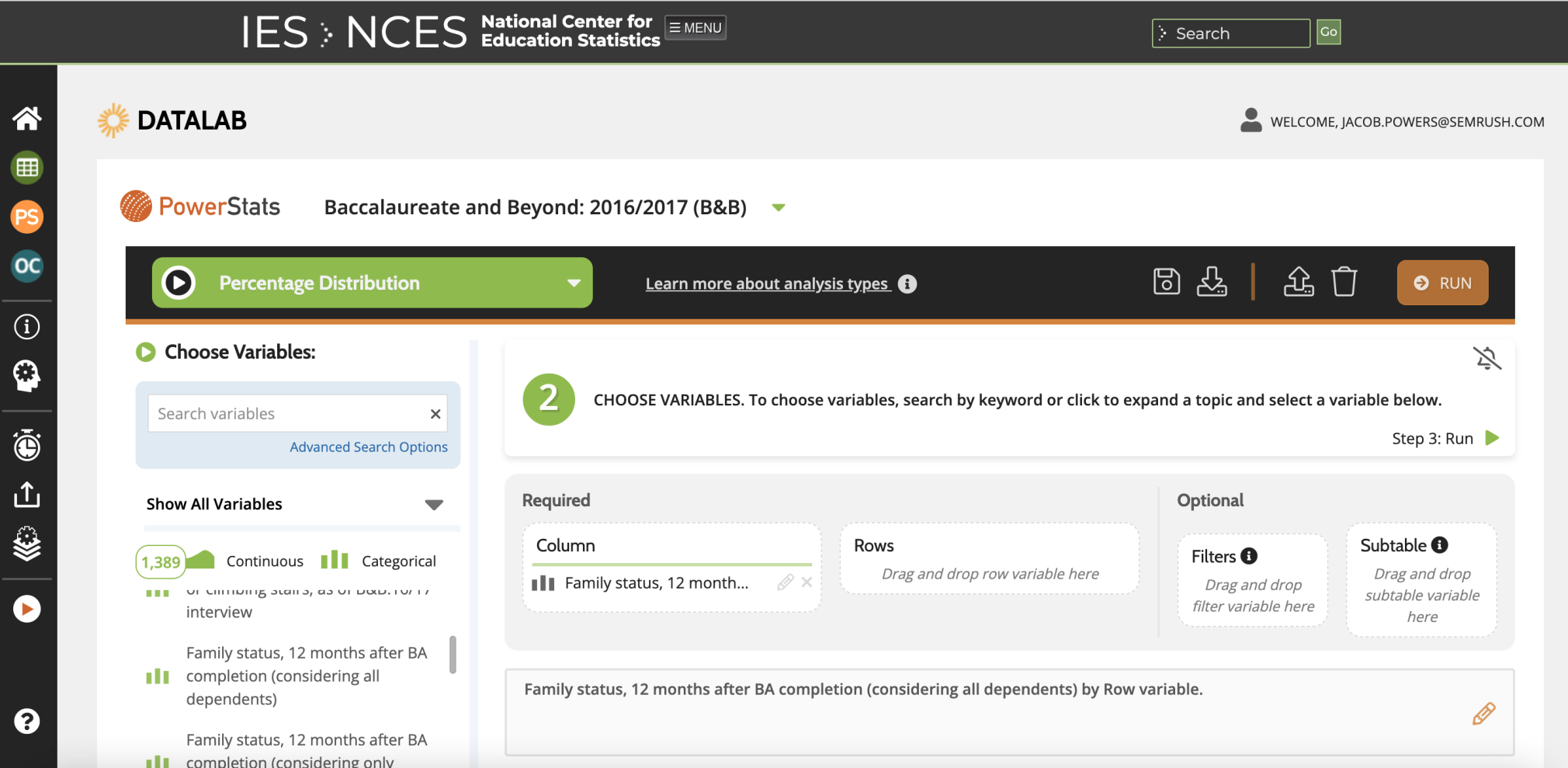
- Industry reports—Industry reports can provide in-depth insights into market audience demographics, and may provide insights into audiences associated with specific niche’s that competitors fall into. Research firms like Forrester and Gartner produce quality reports, though they often come with a high price tag.
- In-house or 3rd party audience research—Many larger companies perform their own in-house audience demographics research in the form of surveys or focus groups. Resources like Survey Monkey or Google Forms can help with this process if you have a way to reach a broad enough audience. 3rd party market research firms are also another option, though the costs tend to be high.
- Audience analytics software—Softwares, such as Semrush’s One2Target tool, provide audience demographics data based on competitor web traffic. These kinds of website demographics analysis tools are often more affordable than 3rd party market research, and provide insights instantly.
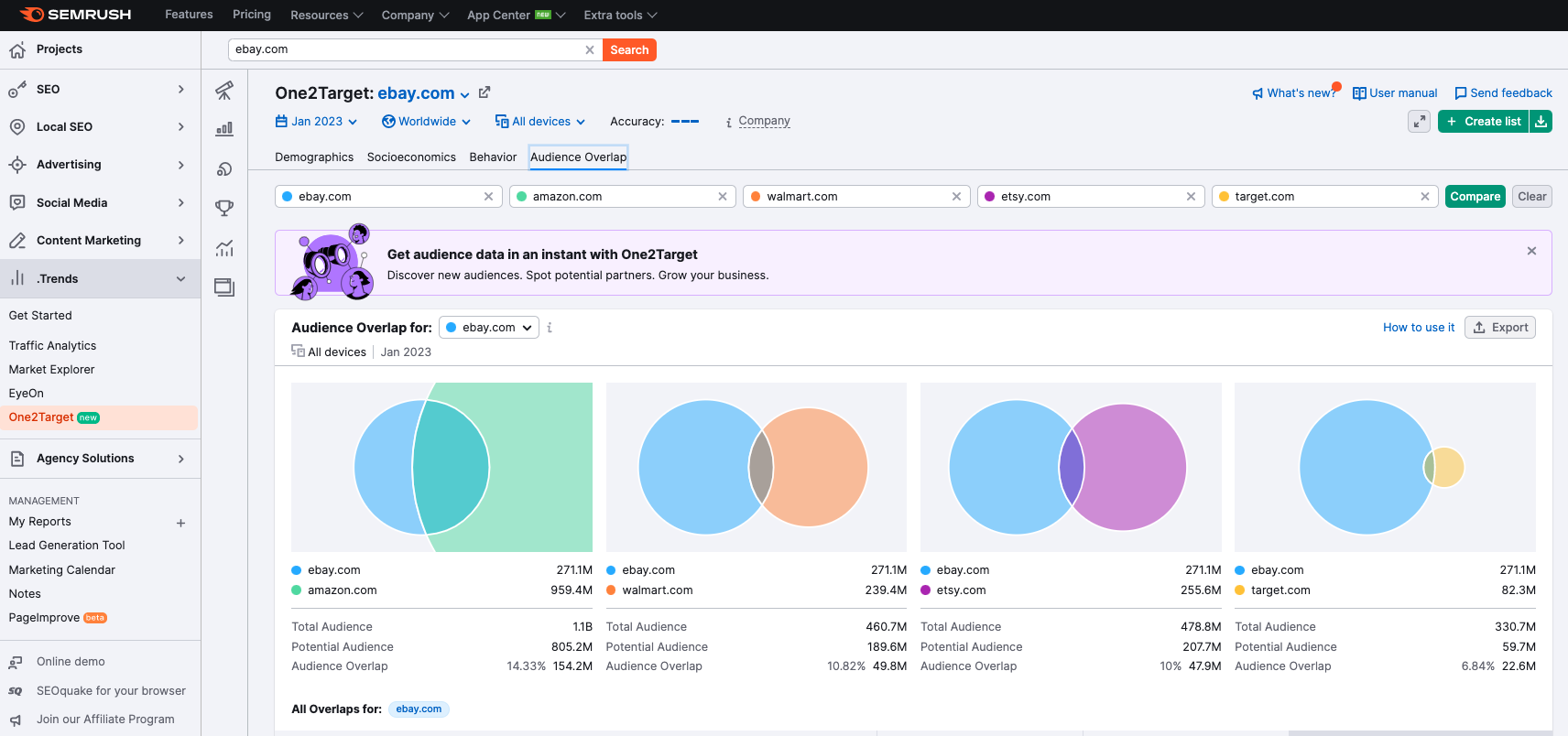
Because competitor data can be difficult (and sometimes expensive) to gather, you may have to get creative as you draw conclusions about competitor demographics.
The benefit of having social media, in-house or third-party provided data, or a traffic based audience analytics tool is that these methods provide precise insights you can apply directly to your strategy.
In the next section, we’ll do a brief overview of a demographics analysis using the Semrush One2Target tool.
A Demographic Audience Analysis Example
Semrush’s One2Target tool provides everything you need to do a full audience analysis of any industry, market, niche, or individual competitor. Let’s take a look at the Demographics Report and the Socioeconomics report in One2Target, both of which provide a ton of data.
For this section, we’ll use the five domains from the cosmetics market to conduct demographic research: sephora.com, ulta.com, byrdie.com, makeupalley.com, and allure.com.
Age & ***
Beginning with the Demographics Report, we can identify the most prevalent age group in this audience and the breakdown of audience among men and women. Here’s a look at the Audience section of the report.

Looking at these charts, we can uncover demographic data for the entire market, and also look at audiences for our individual selected domains.
Generally, the market is mostly made up of women aged 25-44. Looking at specific players, however, we discover some variations. For example, ulta.com has a might higher audience percentage in the 35-44 category than other market players. Likewise, sephora.com has a nearly equal number of men and women in their audience, compared to brands like makeupalley.com, which is nearly ¾ female.
Households
Turning to the Socioeconomics Report, we can review the Households section for information on audience household sizes and income levels.

These charts reveal that the majority of audience households are 3-4 people, and the most common income level is low. Looking at individual players, we discover a few distinctions.
For example allure.com and byrdie.com have higher than average audience segment living in single person households. On the Income Level side, it looks like makeupalley.com has a higher than average number of high income audience members.
Employment & Education
Finally, we can scroll down in the Socioeconomic Report to the Employment Status and Education Level breakdowns.
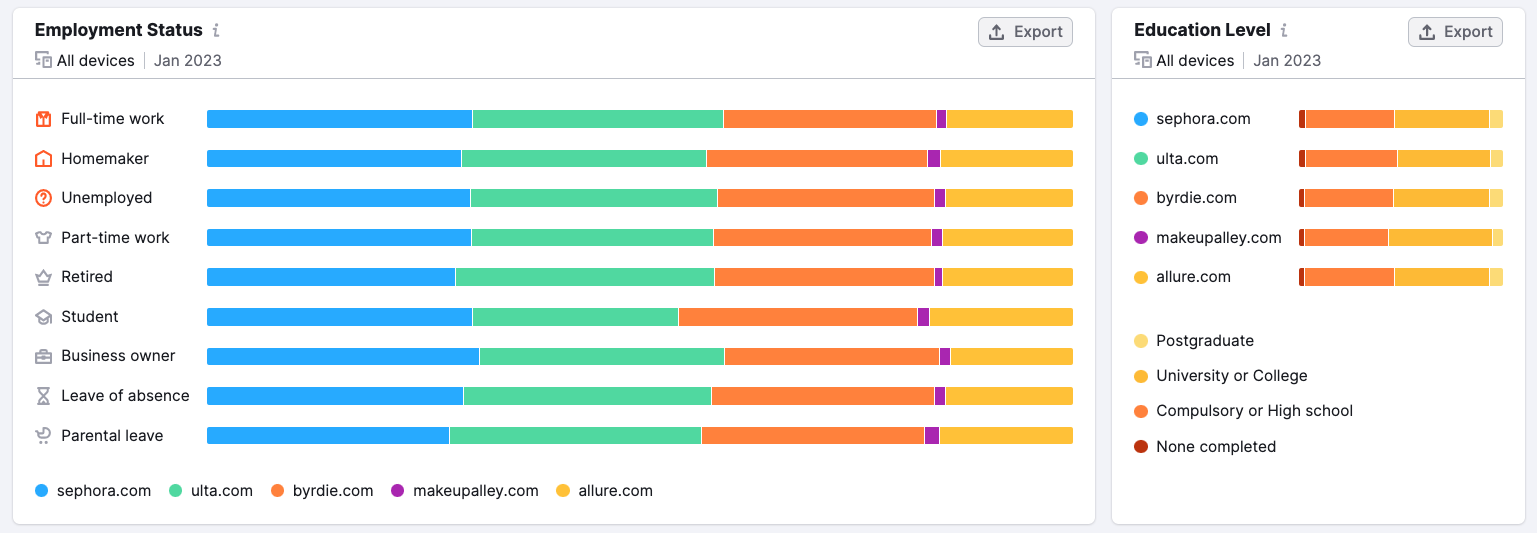
These two graphs show that the top three employment statuses for your audience are Full-time work, Homemaker, and Unemployed. And the largest educational levels are high school or college graduates.
Key Audience Takeaways
Based on the insights from these three graphs, we can develop a demographic profile of our market’s average customer. They’re a female aged 35-44 who has a low income and lives in a household of 3-4 people. They work full-time and have a college degree.
We might also look to other important demographic segments that exist outside of our primary demographic. For example Allure has a high percentage of audience members who are students and a high number of audience members aged 25-34. We could build a second profile based on this demographic information as well.
Based on your demographics-based audience analysis, you can also create user personas to guide your marketing efforts. User personas can help you imagine who your ideal customers are so you can create marketing experiences for specific audiences.
You can check out Semrush’s User Persona Template once you’ve completed your demographics research.
How Can Website Demographic Research Help Your Marketing Strategy?
Once you have an understanding of the demographic data for your competitors and the market as a whole, you can use this information to refine your audience analysis and strengthen your own marketing strategy.
While there are numerous ways to leverage demographic data, here are three examples of how it can improve your marketing:
Tailoring Your Messaging
By understanding our audience’s demographics, we can use language and images that appeal to our target demographic.
Here are two examples of how language differs between ads marketed to women as opposed to men:
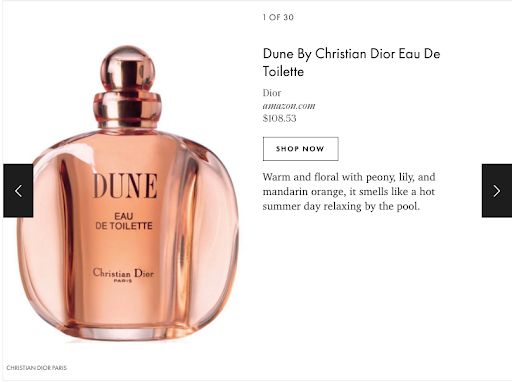
Notice the passive language used in this perfume intended for a female audience. They claim it smells like, “Relaxing by the ****.”

Compare with the language used for this cologne intended for men. The marketers use strong adjectives like “Powerful” and “Raw”.
Optimizing Your Content
Website demographic analysis can give you insights into what types of content your audience is looking for and how to deliver it. Different age groups prefer different kinds of content. For example, Gen Y prefers short form, visually engaging content that is easy to consume on mobile devices.
There are many online resources available to help you understand the different characteristics of various groups, including those broken down by generation. For example, Pew Research has an entire database full of articles exploring various features across generational groups.
Choosing the Right Channels
Website demographics data can help you choose the best social media and advertising channels for reaching your target demographic. Different demographics tend to use different platforms to engage with content. For example, young women tend toward Pinterest and Instagram, while older men tend toward Facebook or Twitter.

Creating Better Offers
Knowing the occupations, incomes, household sizes, education levels, and other demographic data about your audience can help you figure out how to create the right offers for your products or services.
For example, if you know a large portion of your audience is homemakers living in households of 5-6 people, you might create an offer that focuses on value for an entire family. If you’re
targeting a demographic segment that is lower income, you might create an offer that creates a package of products sold at a discounted price.
Different demographic groups will respond differently to various kinds of offers, so thinking strategically about how to present your products or services to your target audience is crucial.
Get to Know Your Potential Customers
Through the close analysis of website demographics, you can build a bold marketing strategy and create effective campaigns that speak clearly to your target demographic. Keep in mind that demographics change over time, and your current customers will also change as time passes.
With regular analysis and optimization, you’ll be able to adapt as your audiences change, and stay ahead of the competition by building a loyal customer base that grows with your business.
Source link : Semrush.com
